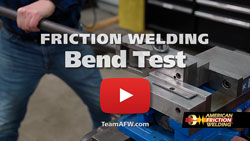Friction welding is superior for welding stainless steel components vs. conventional welding, e.g., MIG welding and TIG welding. Our welding process never uses filler material, high-temperature heat input, or shielding gas and requires minimum pre-weld joint preparation, displacing oils, oxidation, and other contaminations during welding. The metals reach a plasticized state before forging, creating a very narrow heat-affected zone (HAZ), protecting the molecular structure of the components while eliminating porosity and hot cracking. Friction welding creates a bond as strong as the base materials.
Stainless Steel Welding Specifications
AFW works with customers to define a Weld Procedure Specification (WPS) that sets specific tolerance parameters for each part. Equipped with advanced high-precision controllers, our welding centers monitor all critical variables throughout the weld cycle guaranteeing product conformance – RPMs (rotations per minute), PSI (weld pressure), and total stock length loss. Controlling forge ramp and deceleration is critical in maintaining consistent and standardized welds. The operator receives immediate notification if a weld parameter is out of range to take corrective action. We record data from each weld cycle for future parameter review and analysis.
This graph displays RPMs, PSI, and stock displacement during a friction weld cycle.

Stainless Steel Weld Bend Test
Friction welding bend tests are common to assess mechanical integrity and bonding strength. This testing method involves subjecting a friction-welded specimen to bending forces, which simulate real-world conditions and evaluate the weld’s resistance to deformation. A predetermined load is applied gradually to the sample during the test to achieve the desired bend angle. The test measures parameters such as the ultimate bending moment, the yield strength, and the ductility of the weld. By performing friction welding bend tests, engineers and researchers gain valuable insights into the quality and reliability of friction-welded joints, helping to ensure the structural integrity and performance of welded components in various applications.
Friction welding stainless steel does not require stainless steel welding wire or carbon dioxide shielding gas. The solid-state nature of friction welding minimizes the heat-affected zone and prevents distortion, resulting in successful welds with retained mechanical properties. This type of welding is particularly advantageous for stainless steel applications where corrosion resistance is paramount, as it maintains the integrity of the material while achieving reliable bonds.
- Melting Point: 2,550 - 2,790°F | 1,400 - 1,530°C
- Thermal Conductivity: 15 W/m-K (watts per meter per kelvin)
- Grades: Austenitic Stainless Steel, Ferritic Stainless Steel, Duplex Stainless Steel, and Martensitic Stainless Steel
Other Welding Combinations: Carbon Steel to Stainless Steel, Copper to Aluminum, Hastelloy Welding, Inconel to Inconel, Nitronic 50, Stainless Steel to Mild Steel, Stainless to Stainless

